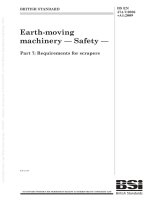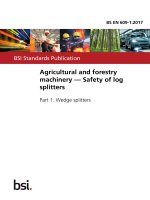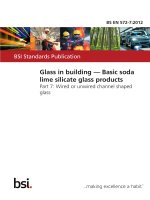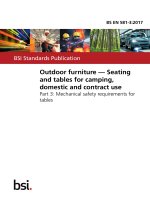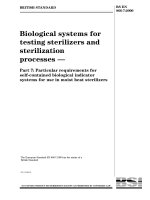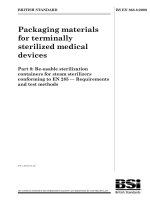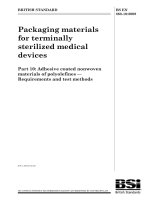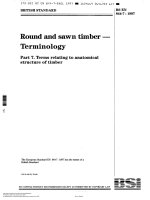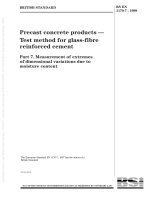Bsi bs en 00868 7 2017
Bạn đang xem bản rút gọn của tài liệu. Xem và tải ngay bản đầy đủ của tài liệu tại đây (1.9 MB, 30 trang )
BS EN 868-7:2017
BSI Standards Publication
Packaging for terminally
sterilized medical devices
Part 7: Adhesive coated paper for low
temperature sterilization processes —
Requirements and test methods
BS EN 868-7:2017
BRITISH STANDARD
National foreword
This British Standard is the UK implementation of EN 868-7:2017. It
supersedes BS EN 868-7:2009 which is withdrawn.
The UK participation in its preparation was entrusted to Technical
Committee CH/198, Sterilization and Associated Equipment and
Processes.
A list of organizations represented on this committee can be
obtained on request to its secretary.
This publication does not purport to include all the necessary
provisions of a contract. Users are responsible for its correct
application.
© The British Standards Institution 2017.
Published by BSI Standards Limited 2017
ISBN 978 0 580 90659 6
ICS 11.080.30; 55.040
Compliance with a British Standard cannot confer immunity from
legal obligations.
This British Standard was published under the authority of the
Standards Policy and Strategy Committee on 28 February 2017.
Amendments/corrigenda issued since publication
Date
Text affected
BS EN 868-7:2017
EN 868-7
EUROPEAN STANDARD
NORME EUROPÉENNE
EUROPÄISCHE NORM
February 2017
ICS 11.080.30
Supersedes EN 868-7:2009
English Version
Packaging for terminally sterilized medical devices - Part
7: Adhesive coated paper for low temperature sterilization
processes - Requirements and test methods
Emballages des dispositifs médicaux stérilisés au stade
terminal - Partie 7: Papier enduit d'adhésif pour des
procédés de stérilisation à basse température Exigences et méthodes d'essai
Verpackungsmaterialien für in der Endverpackung zu
sterilisierende Medizinprodukte - Teil 7:
Klebemittelbeschichtetes Papier für
Niedertemperatur-Sterilisationsverfahren Anforderungen und Prüfverfahren
This European Standard was approved by CEN on 4 December 2016.
CEN members are bound to comply with the CEN/CENELEC Internal Regulations which stipulate the conditions for giving this
European Standard the status of a national standard without any alteration. Up-to-date lists and bibliographical references
concerning such national standards may be obtained on application to the CEN-CENELEC Management Centre or to any CEN
member.
This European Standard exists in three official versions (English, French, German). A version in any other language made by
translation under the responsibility of a CEN member into its own language and notified to the CEN-CENELEC Management
Centre has the same status as the official versions.
CEN members are the national standards bodies of Austria, Belgium, Bulgaria, Croatia, Cyprus, Czech Republic, Denmark, Estonia,
Finland, Former Yugoslav Republic of Macedonia, France, Germany, Greece, Hungary, Iceland, Ireland, Italy, Latvia, Lithuania,
Luxembourg, Malta, Netherlands, Norway, Poland, Portugal, Romania, Serbia, Slovakia, Slovenia, Spain, Sweden, Switzerland,
Turkey and United Kingdom.
EUROPEAN COMMITTEE FOR STANDARDIZATION
COMITÉ EUROPÉEN DE NORMALISATION
EUROPÄISCHES KOMITEE FÜR NORMUNG
CEN-CENELEC Management Centre: Avenue Marnix 17, B-1000 Brussels
© 2017 CEN
All rights of exploitation in any form and by any means reserved
worldwide for CEN national Members.
Ref. No. EN 868-7:2017 E
BS EN 868-7:2017
EN 868-7:2017 (E)
Contents
Page
European foreword....................................................................................................................................................... 4
Introduction .................................................................................................................................................................... 5
1
Scope .................................................................................................................................................................... 6
2
Normative references .................................................................................................................................... 6
3
Terms and definitions ................................................................................................................................... 7
4
Requirements ................................................................................................................................................... 7
5
Information to be supplied by the manufacturer ................................................................................ 9
Annex A (informative) Details of significant technical changes between this European
Standard and the previous edition ........................................................................................................ 10
Annex B (normative) Method for the determination of water repellency ............................................. 11
B.1
Apparatus........................................................................................................................................................ 11
B.2
Reagent ............................................................................................................................................................ 11
B.3
Procedure........................................................................................................................................................ 11
B.4
Repeatability and reproducibility.......................................................................................................... 11
B.5
Test report ...................................................................................................................................................... 12
Annex C (normative) Method for the determination of pore size ............................................................. 13
C.1
Principle .......................................................................................................................................................... 13
C.2
Test liquid ....................................................................................................................................................... 13
C.3
Apparatus........................................................................................................................................................ 13
C.4
Preparation of test specimens ................................................................................................................. 15
C.5
Procedure........................................................................................................................................................ 15
C.6
Result ................................................................................................................................................................ 16
C.6.1
Calculation and expression of results ................................................................................................... 16
C.6.2
Derivation of formula for calculation of equivalent pore radius................................................ 16
C.7
Repeatability and reproducibility.......................................................................................................... 17
C.8
Test report ...................................................................................................................................................... 17
Annex D (normative) Method for the determination of regularity of seal adhesive coatings
on paper........................................................................................................................................................... 18
D.1
Principle of the method ............................................................................................................................. 18
D.2
Apparatus........................................................................................................................................................ 18
D.3
Procedure........................................................................................................................................................ 18
D.4
Test report ...................................................................................................................................................... 18
2
BS EN 868-7:2017
EN 868-7:2017(E)
Annex E (normative) Method for the determination of mass per unit area of uncoated paper
and adhesive coating ................................................................................................................................... 19
E.1
Units................................................................................................................................................................... 19
E.2
Principle of the method .............................................................................................................................. 19
E.3
Apparatus ........................................................................................................................................................ 19
E.4
Procedure ........................................................................................................................................................ 19
E.5
Results .............................................................................................................................................................. 20
E.6
Test report ...................................................................................................................................................... 20
Annex F (normative) Method for the determination of seal strength and mode of specimen
failure ................................................................................................................................................................ 21
F.1
Principle of the method .............................................................................................................................. 21
F.2
Test method .................................................................................................................................................... 21
F.3
Preparation of test-specimen ................................................................................................................... 21
F.4
Procedure ........................................................................................................................................................ 21
F.5
Test report ...................................................................................................................................................... 22
Annex G (informative) Repeatability and reproducibility of test methods ............................................ 23
Bibliography ................................................................................................................................................................. 25
3
BS EN 868-7:2017
EN 868-7:2017 (E)
European foreword
This document (EN 868-7:2017) has been prepared by Technical Committee CEN/TC 102 “Sterilizers
and associated equipment for processing of medical devices”, the secretariat of which is held by DIN.
This European Standard shall be given the status of a national standard, either by publication of an
identical text or by endorsement, at the latest by August 2017, and conflicting national standards shall
be withdrawn at the latest by August 2017.
Attention is drawn to the possibility that some of the elements of this document may be the subject of
patent rights. CEN shall not be held responsible for identifying any or all such patent rights.
This document supersedes EN 868-7:2009.
Annex A provides details of significant technical changes between this European Standard and the
previous edition.
EN 868 consists of the following parts, under the general title Packaging for terminally sterilized medical
devices:
— Part 2: Sterilization wrap — Requirements and test methods;
— Part 3: Paper for use in the manufacture of paper bags (specified in EN 868-4) and in the manufacture
of pouches and reels (specified in EN 868-5) — Requirements and test methods;
— Part 4: Paper bags — Requirements and test methods;
— Part 5: Sealable pouches and reels of porous materials and plastic film construction — Requirements
and test methods;
— Part 6: Paper for low temperature sterilization processes — Requirements and test methods;
— Part 7: Adhesive coated paper for low temperature sterilization processes — Requirements and test
methods;
— Part 8: Re-usable sterilization containers for steam sterilizers conforming to EN 285 — Requirements
and test methods;
— Part 9: Uncoated nonwoven materials of polyolefines — Requirements and test methods;
— Part 10: Adhesive coated nonwoven materials of polyolefines — Requirements and test methods.
In addition, ISO/TC 198 “Sterilization of health care products” in collaboration with CEN/TC 102
“Sterilizers and associated equipment for processing of medical devices” has prepared the
EN ISO 11607- series “Packaging for terminally sterilized medical devices”. The EN ISO 11607- series
specifies general requirements for materials, sterile barrier systems and packaging systems (Part 1)
and validation requirements for forming, sealing and assembly processes (Part 2).
According to the CEN-CENELEC Internal Regulations, the national standards organisations of the
following countries are bound to implement this European Standard: Austria, Belgium, Bulgaria,
Croatia, Cyprus, Czech Republic, Denmark, Estonia, Finland, Former Yugoslav Republic of Macedonia,
France, Germany, Greece, Hungary, Iceland, Ireland, Italy, Latvia, Lithuania, Luxembourg, Malta,
Netherlands, Norway, Poland, Portugal, Romania, Serbia, Slovakia, Slovenia, Spain, Sweden, Switzerland,
Turkey and the United Kingdom.
4
BS EN 868-7:2017
EN 868-7:2017(E)
Introduction
The EN ISO 11607 series consists of two parts under the general title “Packaging for terminally
sterilized medical devices”. Part 1 of this series specifies general requirements and test methods for
materials, preformed sterile barrier systems, sterile barrier systems and packaging systems that are
intended to maintain sterility of terminally sterilized medical devices to the point of use. Part 2 of this
series specifies validation requirements for forming, sealing and assembly processes.
General requirements for all types of sterile barrier systems are provided by EN ISO 11607-1.
The EN 868 series can be used to demonstrate compliance with one or more of the requirements
specified in EN ISO 11607-1.
CEN/TC 102/WG 4 also appreciates the initiatives of CEN with regard to the minimization of adverse
environmental impacts by standards. It was agreed that this subject should be given priority during the
next edition of the EN ISO 11607 series that is the basic reference for all parts of the EN 868 series.
5
BS EN 868-7:2017
EN 868-7:2017 (E)
1 Scope
This European Standard specifies test methods and values for sealable adhesive coated paper
manufactured from paper complying with EN 868-6, used as sterile barrier systems and/or packaging
systems that are intended to maintain sterility of terminally sterilized medical devices to the point of
use. The materials specified in this part are intended to be used for ethylene oxide or irradiation
sterilization.
Other than the general requirements as specified in EN ISO 11607-1 and EN ISO 11607-2 this part of
EN 868 specifies materials, test methods and values that are specific to the products covered by this
European Standard.
The materials specified in this part of EN 868 are intended for single use only.
2 Normative references
The following documents, in whole or in part, are normatively referenced in this document and are
indispensable for its application. For dated references, only the edition cited applies. For undated
references, the latest edition of the referenced document (including any amendments) applies.
EN 20187, Paper, board and pulps - Standard atmosphere for conditioning and testing and procedure for
monitoring the atmosphere and conditioning of samples (ISO 187)
EN ISO 535, Paper and board - Determination of water absorptiveness - Cobb method (ISO 535)
EN ISO 536, Paper and board - Determination of grammage (ISO 536)
EN ISO 1924-2, Paper and board - Determination of tensile properties - Part 2: Constant rate of elongation
method (20 mm/min) (ISO 1924-2)
EN ISO 1974, Paper - Determination of tearing resistance - Elmendorf method (ISO 1974)
EN ISO 2758, Paper - Determination of bursting strength (ISO 2758)
EN ISO 11607-1:2009+A1:2014, Packaging for terminally sterilized medical devices - Part 1:
Requirements for materials, sterile barrier systems and packaging systems (ISO 116071:2006+AMD1:2014)
ISO 2470-2, Paper, board and pulps — Measurement of diffuse blue reflectance factor — Part 2: Outdoor
daylight conditions (D65 brightness)
ISO 3689, Paper and board — Determination of bursting strength after immersion in water
ISO 3781, Paper and board — Determination of tensile strength after immersion in water
ISO 5636-3, Paper and board — Determination of air permeance (medium range) — Part 3: Bendtsen
method
ISO 6588-2:2012, Paper, board and pulps — Determination of pH of aqueous extracts — Part 2: Hot
extraction
ISO 8601, Data elements and interchange formats — Information interchange — Representation of dates
and times
ISO 9197, Paper, board and pulps — Determination of water-soluble chlorides
6
BS EN 868-7:2017
EN 868-7:2017(E)
ISO 9198, Paper, board and pulp — Determination of water-soluble sulfates
3 Terms and definitions
For the purposes of this document, the terms and definitions given in EN ISO 11607-1:2009+A1:2014
apply.
4 Requirements
4.1 General
For any material, preformed sterile barrier system or sterile barrier system, the requirements of
EN ISO 11607-1 shall apply.
This part of EN 868 only introduces performance requirements and test methods that are specific to the
products covered by this part of EN 868 but does not add or modify the general requirements specified
in EN ISO 11607-1.
As such, the particular requirements in 4.3 can be used to demonstrate compliance with one or more
but not all of the requirements of EN ISO 11607-1.
NOTE 1
Compliance to EN 868–7 does not automatically mean compliance to EN ISO 11607-1.
A confirmation of compliance to EN 868-7 shall contain a statement whether EN ISO 11607-1 is
covered.
NOTE 2
When additional materials are used inside the sterile barrier system in order to ease the organization,
drying or aseptic presentation (e.g. inner wrap, container filter, indicators, packing lists, mats, instrument
organizer sets, tray liners or an additional envelope around the medical device) then other requirements,
including the determination of the acceptability of these materials during validation activities, can apply.
4.2 Performance requirements and test methods
NOTE 1
See Annex G for repeatability and reproducibility of the test methods: pore diameters, sulphate
content, chloride content and water repellency. For information on statement of precision and/or bias,
repeatability and reproducibility of other test methods, see EN ISO 11607-1:2009+A1:2014, Table B.1.
NOTE 2
Test methods included in Annex D “regularity of seal adhesive coatings on paper”, Annex E
“Determination of mass per unit area of uncoated paper and adhesive coating” and Annex F “Determination of seal
strength and visual inspection of adhesive coating” have no statement of precision and bias or repeatability and
reproducibility, yet.
4.2.1 When the paper is to be used to manufacture packaging intended to be irradiation sterilized
only, it is not necessary for it to have wet strength properties or any permeability to air, so 4.2.12 and
4.2.17 need not apply.
4.2.2 No colour shall leach out of the paper. Compliance shall be tested by visual examination of a hot
aqueous extract prepared in accordance with the method given in ISO 6588-2.
4.2.3 The average mass of 1 m2 of the conditioned coated paper when tested in accordance with
EN ISO 536 shall be within ± 7,5 % of the nominal value stated by the manufacturer.
4.2.4 The pH of an aqueous extract of the coated paper shall be not less than 5 or greater than 8 when
tested in accordance with ISO 6588-2, hot extraction method.
7
BS EN 868-7:2017
EN 868-7:2017 (E)
4.2.5 The chloride content of the paper, calculated as sodium chloride, shall not exceed 0,05 % when
tested in accordance with ISO 9197 using an hot extract prepared in accordance with ISO 6588-2:2012,
7.2 except that 2 ml of potassium chloride solution is not added.
4.2.6 The sulphate content of the paper, calculated as sodium sulphate, shall not exceed 0,25 % when
tested in accordance with ISO 9198, using an hot extract prepared in accordance with ISO 6588-2:2012,
7.2 except that 2 ml of potassium chloride solution is not added.
4.2.7 When tested in accordance with ISO 2470-2 the material shall not exhibit an increase in D65
brightness, due to the optical brightener agents, of more than 1 %; calculated as the ratio of the D65
brightness measured with the 420 nm UV-cut-off filter in place to the D65 brightness measured without
420 nm UV-cut-off filter.
4.2.8 When exposed at 25 cm from a UV light source, the material shall not have per 0,01 m2 more
than five fluorescent spots, each having an axis greater than 1 mm.
NOTE
The UV light to be used is the one described as per Annex B.
4.2.9 The internal tearing resistance of the conditioned paper shall be not less than 300 mN in both
machine and cross directions when tested in accordance with EN ISO 1974.
4.2.10 The air permeance of the conditioned coated paper shall be not less than 0,2 µm/Pa ⋅ s and not
more than 6,0 µm/Pa ⋅ s when tested in accordance with ISO 5636-3.
4.2.11 The bursting strength of the conditioned paper shall be not less than 200 kPa when tested in
accordance with EN ISO 2758.
4.2.12 The wet bursting strength of the paper shall be not less than 35 kPa when tested in accordance
with ISO 3689 using an immersion time of 10 min.
4.2.13 The water repellency of the paper shall be such that the penetration time is not less than 20 s
when tested in accordance with Annex B.
4.2.14 When tested in accordance with Annex C, the average of the pore diameters of the ten test
coated pieces shall be lower than or equal to 20 µm. No value shall be greater than 30 µm.
4.2.15 The coating shall be continuous and regular with no uncoated areas or discontinuity in the
coating pattern which could provide gaps or channels in a seal when tested and examined in accordance
with Annex D.
4.2.16 The tensile strength of the conditioned paper shall be not less than 4,0 kN/m in machine
direction and not less than 2,0 kN/m in cross direction when tested in accordance with EN ISO 1924-2.
4.2.17 The wet tensile strength of the paper shall be not less than 0,80 kN/m in machine direction and
not less than 0,40 kN/m in cross direction when tested in accordance with ISO 3781.
4.2.18 The surface absorbency of each side of the paper shall be not more than 20 g/m2 when tested in
accordance with EN ISO 535 using a 60 s exposure time (Cobb method).
4.2.19 The mass per unit area of seal adhesive coating shall be within ± 2 g/m2 of that stated by the
manufacturer when tested in accordance with Annex E.
4.2.20 The seal strength of the coated paper shall be greater than 0,08 kN/m (1,20 N/15 mm) but not
so strong as to cause fibre tear when tested in accordance with Annex F.
8
BS EN 868-7:2017
EN 868-7:2017(E)
Report whether the tail was supported or unsupported, see F.5.
4.3 Marking of transport packaging
The transport packaging shall be legibly and durably marked with the following information:
a) reference, stock or catalogue number;
b) quantity;
c) the name or trade name and address of the manufacturer;
d) date of manufacture in accordance with ISO 8601;
e) lot number 1;
f)
nominal sheet size or nominal width of rolls in millimetres and length in metres;
g) the recommended storage conditions;
h) nominal mass in grams per square metre;
i)
intended for single use only.
5 Information to be supplied by the manufacturer
The manufacturer shall supply instructions for recommended sealing and/or closure conditions and for
the monitoring of critical parameters of seal and/or closure integrity.
NOTE 1
NOTE 2
For validation of closure and sealing conditions, see EN ISO 11607-2.
For heat seals these parameters include the range of temperature, pressure and time.
1 A reference number in order to trace the manufacturing history of the product.
9
BS EN 868-7:2017
EN 868-7:2017 (E)
Annex A
(informative)
Details of significant technical changes between this European Standard
and the previous edition
Changes between this European Standard and EN 868-7:2009 are the following:
a) changes in order to align this European Standard with the EN ISO 11607 series, in particular by:
1) elucidating the requirements given by EN ISO 11607-1 as general requirements for this
standard;
2) formulating the significance and limits of the requirements of this standard with respect to the
requirements given by EN ISO 11607-1;
3) linking the test methods with regard to information on statement of precision and bias,
repeatability and reproducibility to EN ISO 11607-1:2009+A1:2014, Table B.1;
b) the test method on fluorescence is in accordance with ISO 2470-2. The test method according
Annex B has been deleted;
c) the test method for determination of seal strength and mode of specimen failure as per Annex F has
been amended;
d) updating of the following test methods by a statement of repeatability and reproducibility:
1) method for the determination of water repellency as per Annex B;
2) method for the determination of pore size as per Annex C;
e) providing of informative data for repeatability and reproducibility of the following test methods as
per Annex D:
1) method for the determination of water repellency as per Annex B;
2) method for the determination of pore size as per Annex C;
3) chloride content;
f)
4) sulphate content;
updating of the bibliography.
NOTE
10
This list is not exhaustive.
BS EN 868-7:2017
EN 868-7:2017(E)
Annex B
(normative)
Method for the determination of water repellency
B.1 Apparatus
B.1.1 An ultraviolet light source and light meter with a range of wavelength of 315 nm to 380 nm.
B.1.2 Flat dish, approximately 200 mm x 150 mm x 15 mm.
B.1.3 Desiccator.
B.1.4 Stopwatch.
B.1.5 Powder dispenser, with a sieve of nominal aperture size between 0,125 mm and 0,150 mm at
one end and closed at the other.
B.2 Reagent
Dry indicator powder prepared as described below.
Grind 20 g of sucrose in a mortar and pass through a sieve of nominal aperture size 0,063 mm to
0,075 mm. Dry the sieved sucrose in a desiccator over silica gel or in an oven at 105 °C to 110 °C. Mix
10 g of the dry sucrose with 10 mg of sodium fluorescein and pass the mixture 5 times through a sieve
of nominal aperture size 0,063 mm to 0,075 mm and finally transfer the dry indicator powder to the
powder dispenser.
The dry indicator powder in the powder dispenser should be stored either in a desiccator or in an oven
at 105 °C to 110 °C.
B.3 Procedure
Take 10 test pieces of conditioned paper, each of size 60 mm x 60 mm. Separate the samples into two
groups of five, one group with the 'wire-side' uppermost and the other with the 'top-side' uppermost.
For each sample make two folds, each 10 mm high at right angles along two edges. Fill the flat dish with
purified water at the conditioning temperature to a depth of 10 mm. Switch on the UV lamp and allow it
to develop full output and adjust the distance of the lamp so that the irradiance at the level of the water
in the dish is (300 ± 20) µW/cm2. Sprinkle the upper surface of a test piece thinly with indicator powder
from the dispenser. Float the test piece on the water under the UV light source and note the time taken
for a general fluorescence to appear. Repeat the procedure with the remaining nine test pieces.
The water repellency of the paper is considerably influenced by the temperature of the water which
shall be maintained within the specified limits (23 ± 1) °C.
B.4 Repeatability and reproducibility
See Annex G for repeatability and reproducibility of the test method.
11
BS EN 868-7:2017
EN 868-7:2017 (E)
B.5 Test report
The test report shall include the following information:
a) the mean penetration time in seconds for each side of the paper;
b) on request, the identification of the product under test, the identification of the test-house and the
date;
c) the normative reference of the test method.
12
BS EN 868-7:2017
EN 868-7:2017(E)
Annex C
(normative)
Method for the determination of pore size
C.1 Principle
The pressure required to force air bubbles through the interstices of a material, wetted by a liquid and
having a film of the same liquid applied to its upper surface, is observed. This pressure together with
the known surface tension of the liquid is used to estimate the size of the interstices in the material.
C.2 Test liquid
The test liquid used should allow the paper to be wetted completely, have low solvent power for
proofing materials, cause no swelling of the fibres, have constancy of surface tension, non-toxicity, low
flammability, freedom from foaming, and moderate cost.
NOTE
Ethanol R has been found to be suitable.
C.3 Apparatus
C.3.1
The apparatus is shown diagrammatically in Figure C.1. The principal parts are as follows:
a) the testing head “1”: a cylindrical vessel of an appropriate material (e.g. brass) over which the
specimen “a” can be clamped by a clamping ring “b” and screw “c”. It is fitted with a synthetic
rubber gasket “d” of 50 mm internal diameter to make a seal against the specimen;
b) pressure measuring device;
c) a stop-valve which serves to direct air to the testing head;
d) a variable flow valve set to give the required rate of rise of pressure in “1”;
e) a stop-valve which directs air to the pressure measuring device;
f)
air reservoir of about 2,5 l capacity connected to “1”; this ensures that the rate of flow of air
necessary to maintain the required rise of pressure is so large that the loss of air through the
material when bubbling begins will not reduce the rate of rise of pressure;
g) the air supply.
C.3.2
Using the apparatus shown in Figure C.1 the test is conducted as follows:
Turn on the air supply. Open valve “3” to direct air to the test head via reservoir “6”, and adjust valve “4”
to give the required rate of pressure rise. Leave stop-valve “5” open during testing. When the first
bubble appears in the test material, “5” is closed to allow the pressure reached to be read from the
measuring device “2”.
13
BS EN 868-7:2017
EN 868-7:2017 (E)
Key
1 testing head
2 pressure measuring device
3, 5 stop valve
4 variable blow valve set
6 air reservoir
7 air supply
a
b
c
d
specimen
clamping ring
screw
rubber gasket
Figure C.1 — Diagrammatic representation of the apparatus for the determination of the pore
size
C.3.3
Apparatus for measurement of the equivalent pore size, having the following characteristics:
a) Means shall be provided for clamping the specimen of material in such a manner that:
1) it is horizontal;
2) a circular area of the material 50 mm in diameter will be subjected to steadily increasing air
pressure on the lower face;
3) no leakage of the test liquid occurs during the test period;
4) the specimen does not slip in the clamps.
NOTE 1
The clamps need to be faced with resilient material which is resistant to the test liquid. With some
forms of apparatus, it has been found that the correct conditions of clamping can be attained if the clamps are
faced with a suitable grade of synthetic rubber.
b) The rate of increase in air pressure shall be 2 kPa/min to 2,5 kPa/min (200 mm head of water per
minute to 250 mm head of water per minute). 2
2
14
1 mm head of water = 9,80655 Pa.
BS EN 868-7:2017
EN 868-7:2017(E)
c) A pressure measuring device connected to the test head shall be calibrated in kilopascals (or
millimetres head of water).
d) The pressure measuring device shall have a suitable range.
NOTE 2
A pressure measuring device which provides for pressure up to 6 kPa (600 mm head of water) is
suitable for most materials. A pressure measuring device providing pressures of up to 10 kPa (1 m head of water)
is used for measurements on close materials, e.g. ventile, clean room overalls, theatre clothing and drapes.
C.4 Preparation of test specimens
After receipt, handle the material as little as possible and do not sharply fold, iron or treat in any way
other than by conditioning. Cut specimens from the material in shape convenient for handling and
clamping. Take the test specimens from different places in the material, avoiding any creases, so that
they represent the material as fully as possible.
NOTE
For most types of apparatus, it is convenient to cut specimens from the material in the form of
75 mm x 75 mm squares.
Unless otherwise stipulated, test 10 specimens from any sample of material submitted.
C.5 Procedure
C.5.1
Conduct the test in the standard atmosphere for testing specified in EN 20187.
C.5.2 Determine the surface tension of the test liquid by any convenient method to the nearest
0,5 mN/m.
NOTE
Within the range of the standard atmosphere, the surface tension of Ethanol R usually lies between
22 mN/m and 24 mN/m, with a temperature coefficient of - 0,005 mN/(m ⋅ K). The Wilhelmy stalagmometer,
single and double capillary methods have all been found satisfactory for measuring surface tension.
C.5.3 Soak the conditioned specimen under about 15 mm (depth) of the test liquid in a glass dish.
After soaking for a minimum period of 3 min remove the specimen with forceps and clamp it on the
testing head. Pour a few millilitres of the test liquid onto the surface of the material; pour just sufficient
to cover the material completely after it has bulged slightly under the pressure exerted on the
underside during the test. Record the temperature of the test liquid at this stage.
NOTE
Very porous material, if relevant, can be more easily tested if the air pressure is allowed to increase on
the underside of the specimen and bulge the specimen before the test liquid is poured on to cover the surface of
the material completely.
C.5.4 Under increasing air pressure, bubbles appear at different places over the upper surface;
observe the specimen continuously whilst the pressure is increasing and record, to the nearest
millimetre, the pressure at which the first bubble appears on the upper surface.
C.5.5
Test further specimens until the requisite number of results is obtained.
15
BS EN 868-7:2017
EN 868-7:2017 (E)
C.6 Result
C.6.1 Calculation and expression of results
Calculate the equivalent pore radius r in micrometres for each specimen by means of the formula:
r = 2T ⋅106 / ρ ⋅ p ⋅ g
or simplified
=
r 204 ⋅ T / p
where
(C.1)
(C.2)
T is the surface tension of the test liquid at the temperature of the test, in mN/m;
g
is the acceleration due to gravity, in mm/s2;
ρ
is the density of water at the temperature of the test, in mg/mm3;
p
is the bubble pressure, in millimetres head of water.
Calculate the mean pore radius and express the result as pore diameter.
NOTE 1
The error introduced by taking ρ = 1 mg/mm3 for the relative density of water at the temperature of
the standard atmosphere for testing is small compared with the variability of the test results.
NOTE 2
Similarly, although g is known to vary about 0,5 % from place to place, the error introduced by
assuming a constant value of 9 810 mm/s2 is small compared with the variability of the test.
C.6.2 Derivation of formula for calculation of equivalent pore radius
For a cylindrical tube, the pressure p in Pascals, necessary to force liquid through, is given by the
following formula:
p=
where
T
2T cos Q
r
(C.3)
is the surface tension of liquid, in N/m;
Q is the contact angle at liquid-solid-air interface, in degrees;
r
is the radius of tube, in metres.
This is the Laplace formula (see [4]).
The contact angle is very difficult to measure and therefore a liquid is chosen which completely wets the
material, thus cos Q = 1 and the formula becomes:
p=
2T
r
This formula is the same as the simplified formula given in C.6.1.
(C.4)
The pressure is normally measured in millimetres head of water, because either a water manometer is
used, or the pressure measuring device is calibrated in millimetres head of water.
16
BS EN 868-7:2017
EN 868-7:2017(E)
Thus
p = pb ⋅ ρ ⋅ g
where
pb
ρ
g
(C.5)
is the head of water, in millimetres head of water;
is the density of water, in mg/mm3;
is the acceleration due to gravity, in mm/s2.
C.7 Repeatability and reproducibility
See Annex G for repeatability and reproducibility of the test method.
C.8 Test report
The test report shall include the following information:
a) the equivalent pore diameter in micrometres for each specimen and the mean pore diameter in
micrometres for the sample;
b) details of any deviation from the specified procedure;
c) on request, the identification of the product under test, the identification of the test-house and the
date;
d) the normative reference of the test method.
17
BS EN 868-7:2017
EN 868-7:2017 (E)
Annex D
(normative)
Method for the determination of regularity of
seal adhesive coatings on paper
D.1 Principle of the method
A dye solution is applied to the surface of the adhesive coating and the excess wiped off. Visual
examination of the coloured surface determines the regularity of the coating.
D.2 Apparatus
a) Cotton gauze swabs;
b) Cotton cloth;
c) Dye solution prepared by dissolving 5 g Malachite Green in 1 000 ml of 10/90 (V/V) methylated
spirit/water mixture.
D.3 Procedure
Spread the dye solution over the coated surface of the paper with swabs soaked in it. Wipe off any
excess quickly using the clean cotton cloth. The dye will stain uncoated paper so the regularity of the
coating can be checked visually.
D.4 Test report
The test report shall include the following information:
a) the result of the visual examination;
b) on request, the identification of the product under test, the identification of the test-house and the
date;
c) the normative reference of the test method.
18
BS EN 868-7:2017
EN 868-7:2017(E)
Annex E
(normative)
Method for the determination of mass per unit area of uncoated paper and
adhesive coating
E.1 Units
All results shall be reported in units of grams per square metre (g/m2).
E.2 Principle of the method
Samples of known areas are cut out and weighed. The adhesive coating is removed by extracting in a
solvent. The paper is dried, allowed to condition and then re-weighed.
The difference in mass between the original and the extracted samples is determined and the
appropriate factor is applied to obtain the mass of the extracted coating.
E.3 Apparatus
E.3.1
Hardened metal template
Recommended dimensions
100 mm x 100 mm – factor 100;
100 mm x 50 mm – factor 200.
E.3.2
Flat cutting sheet
E.3.3
Cutting tool with sharp blade or alternatively a combined circular cutter.
E.3.4 Continuous extraction apparatus e.g. soxhlet comprising an extraction tube of approximately
100 ml volume and a reflux flask of 250 ml volume without the use of a cartridge.
E.3.5
E.3.6
E.3.7
Electric thermostatically controlled flask heater sited in fume cupboard.
Fume cupboard with extraction fan and ventilation.
Analytical balance capable of measuring accurately to 0,1 mg.
E.3.8
Solvent
E.3.9
Gloves, safety glasses, tongs.
E.4 Procedure
E.4.1
E.4.2
Allow the test sample to condition.
Place the material to be tested on the cutting sheet.
19
BS EN 868-7:2017
EN 868-7:2017 (E)
E.4.3 Place the template on the material, position firmly and cut around the edges with the cutting
tool – alternatively use the circular cutter.
E.4.4 Cut out 10 samples in such a way as to get a good coverage across and along the sheet being
tested.
E.4.5
Identify each sample by numbering with a pencil.
E.4.6 Weigh the samples individually on the analytical balance and record the mass of each alongside
its number.
E.4.7 Add 150 ml of the solvent to the flask, extract the samples for 1 h regulating the heating so that
the solvent in the extraction tube is renewed every 5 min.
E.4.8
E.4.9
Remove the samples with tongs.
Dry off any solvent with a warm air current.
E.4.10 Allow the samples to recondition for 24 h at (23 ± 2) °C and (50 ± 5) % relative humidity.
E.4.11 Reweigh the samples against their identification as in E.4.5 and E.4.6.
E.5 Results
Calculate the mass per square metre of the adhesive coating by the following formula:
m3 = ( m1 − m2 ) × ft
where
ft
m1
m2
m3
m1 x ft
m2 x ft
(E.1)
is the template factor;
is the initial mass of the sample in grams;
is the mass of sample after extracting and reconditioning in grams;
is the mass of the adhesive coating removed, in grams per square metre;
= mass per square metre of coated paper;
= mass per square metre of uncoated paper.
E.6 Test report
The test report shall include the following information:
a) the maximum, minimum and average masses for uncoated paper and adhesive coating;
b) on request, the identification of the product under test, the identification of the test-house and the
date;
c) the number of the standard that has been used for the test.
20
BS EN 868-7:2017
EN 868-7:2017(E)
Annex F
(normative)
Method for the determination of seal strength and mode of specimen failure
F.1Principle of the method
The adhesive coating is sealed to a specified sealing substrate under controlled conditions. The seal
strength is determined by cutting a strip at 90° through the seal and pulling it apart on a tensile-testing
machine meeting the requirements of EN ISO 11607-1:2009+A1:2014, Annex B.
F.2Test method
F.2.1
F.2.2
NOTE
F.2.3
Test method: see EN ISO 11607-1:2009+A1:2014, Annex B.
Sealing substrate: The specification of the material used shall be documented.
It is suggested to use e.g. 17 g/m2 polyester coated with 34 g/m2 polyethylene or similar.
Laboratory heat sealer.
F.3Preparation of test-specimen
F.3.1
Set the sealer to the conditions specified by the manufacturer (see Clause 5).
NOTE
In some cases specific laboratory sealing equipment and sealing substrates require adjustment of
sealing conditions to achieve the required results.
F.3.2 Make test seals by sealing together the adhesive coated side of the paper with the sealing side of
the sealing substrate.
F.3.3 Cut five strips 15 mm wide following sampling instructions of EN ISO 11607-1:2009+A1:2014,
Annex B.
F.4Procedure
F.4.1 Following the guidelines of EN ISO 11607-1:2009+A1:2014, Annex B pull the seals apart at a
grip separation rate of 200 mm/min and record the average force over the middle of the measured seal
profile curve by discarding 10 % on each side of the measuring curve.
Results shall be reported in units N/15mm. In order to produce comparable data, it is recommended to
use EN ISO 11607-1:2009+A1:2014, Annex B (supported tail of the specimen).
NOTE
Gripping the tail end during manual support can negatively influence the results.
F.4.2 Visually inspect the seal patterns of the surface of the film and determine the mode of failure
(e.g. adhesive or cohesive peel). Inspect the surface of the paper for delamination respectively fibre tear.
21
BS EN 868-7:2017
EN 868-7:2017 (E)
F.4.3 Elements to be documented in the test procedure include but are not limited to:
a) sealing temperature, pressure and time;
b) sealing device configuration;
c) sample orientation in sealing device and testing machine.
F.5Test report
The test report shall include the following information:
a) the identification of the product under test, sealing substrate used, the identification of the test
laboratory and the date;
b) the seal strength determined as per F.4.1 for each of the sample tested expressed in N/15 mm,
results for machine and cross direction tested samples shall be reported separately;
c) the mode of failure determined as per F.4.2 and whether delamination or fibre tear has been
observed;
d) if the test has been performed with the tail unsupported or supported, and other specifications, if
applicable;
e) the reference of the standards used for the test.
22
BS EN 868-7:2017
EN 868-7:2017(E)
Annex G
(informative)
Repeatability and reproducibility of test methods
The precision of the following test methods have been assessed by a Round Robin Test protocol in 2010
and 2011, conducting a precision experiment as described in ISO 5725-2:
— pore size;
— water repellency;
— chloride content;
— sulfate content.
Table G.1 summarizes core conditions of interlaboratory testing. Table G.2 summarizes the significance
of results.
Table G.1 — Test matrix
Pore size
Water
repellency
Chloride
content
Sulfate
content
Number of
Laboratories
Number
of test
runs
Replication
Number of
sample materials
7
3
9
16
10
4
Plain paper,
creped paper
3
7
2
4
Plain paper
3
7
10
2
3
4
Type of
materials
Fine creped
paper, Plain
paper, creped
paper
Plain paper
23
